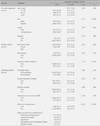Abstract
Purpose
The present study was to apply the Attitudes-Social influence-Efficacy (ASE) model in order to identify factors associated with the assertive behavior of non-smoking college students when they are exposed to secondhand smokes in Korea.
Methods
Data were collected from non-smoking college students (N=1,656, 76.6% female) at two universities in Seoul and Gyeonggi-do. The main outcome measure was the assertive behavior. ASE factors such as attitudes toward being assertive, social influences, and self-efficacy as well as socio-demographic, health- related, and smoking-related factors were self-administrated.
Results
The mean of the assertive behavior (range 1~5 points) was 2.23; 37.6% was not at all assertive, while 4.3% was always assertive. Higher assertiveness was significantly correlated with a higher level of positive attitude, social influence and self-efficacy (p<.05 for all). Stepwise multiple regression analyses showed that the social influence was the strongest factor associated with the assertive behavior (β=0.430, p<.001, R2=.246), followed by self-efficacy, motive to assertiveness, having any family member who had diseases, and male gender. These factors explained the assertive behavior by 39.7%.
Figures and Tables
Table 1
Sociodemographic, Health- and Smoking-related Factors and Assertive Behavior Levels (N=1,656)

References
1. Aspropoulos E, Lazuras L, Rodafinos A, Eiser JR. Can you please put it out? Predicting non-smokers' assertiveness intentions at work. Tob Control. 2010; 19:148–152.

2. Bandura A. Social foundations of thought and action: A social cognitive theory. Englewood Cliffs: Prentice-Hall;1986.
3. Choi S, Oh H. Korean women's clothing behaviors observed by the Korean who has lived in the U.S.A. J Korean Home Econ Assoc. 2001; 39(1):11–27.
4. Choo J, Kim E. Levels of secondhand smoking and their correlates for college students in Korea. In : Paper presented at the meeting of Korean Society for Health Promotion and Disease Prevention; Seoul, Korea.
5. Chon MY, Kim MH, Cho CM. Predictors of health promoting lifestyles in Korean undergraduate students. J Korean Soc Health Educ Promot. 2002; 19(2):1–13.
6. Fishbein M, Ajzen I. Belief, attitude, intention, and behavior: An introduction to theory and research. Reading: Addison-Wesley;1975.
7. Glymour MM, Defries TB, Kawachi I, Avendano M. Spousal smoking and incidence of first stroke the health and retirement study. Am J Prev Med. 2008; 35(3):245–248.
8. Gottlieb NH, Eriksen MP, Lovato CY, Weinstein RP, Green LW. Impact of a restrictive worksite smoking policy on smoking behavior, attitudes and norms. J Occup Med. 1990; 32:16–23.
9. Helgason AR, Lund KE. Environmental tobacco smoke exposure of young children-attitudes and healthrisk awareness in the Nordic countries. Nicotine Tob Res. 2001; 3(4):341–345.
10. Hughes SC, Corcos IA, Hofstetter CR, Hovell MF, Seo DC, Irvin VL, et al. Secondhand smoke exposure among nonsmoking adults in Seoul, Korea. Asian Pac J Cancer Prev. 2008; 9:247–252.
11. Humble C, Croft J, Gerber A, Casper M, Hames CG, Tyroler HA. Passive smoking and 20-year cardiovascular disease mortality among nonsmoking wives. Am J Public Health. 1990; 80(5):599–601.
12. Im HS. The Korean social changes and value. Seoul: Nanam;1996.
13. Lee AH. A pilot intervention for pregnant women in Sichuan, China on passive smoking. Patient Educ Couns. 2008; 71(3):396–401.

14. Lin PL, Huang HL, Lu KY, Chen T, Lin WT, Lee CH, et al. Secondhand smoke exposure and the factors associated with avoidance behavior among the mothers of pre-school children: A school-based cross-sectional study. BMC Public Health. 2010; 10:606.

15. Lund KE, Helgason AR. Environmental tobacco smoke in Norwegian homes, 1995 and 2001: Changes in children's exposure and parents attitudes and health risk awareness. Eur J Public Health. 2005; 15(2):123–127.

16. Ministry for Health, Welfare and Family Affairs. 2009 Yearbook of Health, Welfare and Family Statistics. 2009. Retrieved July, 2010. from http://stat.mw.go.kr/stat/data/cm_data_view.Jsp?menu_code=MN02010000&cont_seq=13118&page=1&search_key=&search_word=.
17. Ministry for Health, Welfare and Family Affairs. 2008 Statistics for people's health. 2008. Retrieved October, 2009. from http://stat.mw.go.kr/stat/data/cm_data_view.jsp?menu_code=MN01010402&cont_seq=14713.
18. Prochaska JO, DiClemente CC, Norcross JC. In search of how people change: Applications to addictive behaviors. Am Psychol. 1992; 47(9):1102–1114.

19. Sim HS, Lee KS, Hong HS, Meng KH. The awareness and countermeasures against harmful effect of passive smoking in Korean adults. Korean J Prev Med. 2000; 33(1):91–98.
20. Yoon HS, Cho YC. A study on preventive attitudes and health behavior of life-style related disease in college students. J Korean Soc Health Educ Promot. 2005; 22(4):245–256.




 PDF
PDF ePub
ePub Citation
Citation Print
Print





 XML Download
XML Download